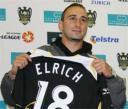Over the past three seasons, Australia’s marquee player system has quickly settled into two clear classes — the overseas marquee players and local players (usually, but not necessarily, returning from stints in one of the many European leagues).
Season 1 — 2005/06
There were two Australian marquee players in the opening season the A-League. Both players were enticed back to Australia from Europe.
Ned Zelic
A former Socceroo who had quit the team due to differences with then coach Frank Farina, Zelic returned to Australia on a 2 year contract with the Newcastle Jets. He played a key role in the defence for the season, which saw Newcastle eliminated in the semi-finals. In the off-season Zelic was released from his contract for personal reasons and returned to play in Europe.
Archie Thompson
 A current Socceroo and world record holder for the number of goals scored in an international match (13 in the 31-0 humiliation of Western Samoa), Thompson featured high on the goal scorer’s list while playing for Melbourne Victory. Unfortunately his goal scoring efforts couldn’t drag Victory any higher than second bottom on the table.
A current Socceroo and world record holder for the number of goals scored in an international match (13 in the 31-0 humiliation of Western Samoa), Thompson featured high on the goal scorer’s list while playing for Melbourne Victory. Unfortunately his goal scoring efforts couldn’t drag Victory any higher than second bottom on the table.
Season 2 — 2006/07
Stan Lazaridis

Archie Thompson
Thompson became the first marquee (local or overseas) to front up for a second season from the first game in 2006/07. Thompson scored heavily again in Season 2, including 5 goals in Victory’s 6-0 pounding of Adelaide Reds in the 2006/07 Grand Final. Thompson once again achieved what he was signed to do — score goals.
Tony Vidmar

Season 3 — 2007/2008
Once again the local marquee players continued the practice of coming back for another season, an indication of both the players’ commitment to the game as well as their success on the pitch as the clubs were prepared to keep paying them to come back.
Paul Agostino
An ex-Socceroo striker returning for the 2007/08 season from the Bundesliga team 1860 Munich, Agostino scored just 4 goals for Adelaide United Reds in a season that saw his team finish third last.
Ahmad Elrich

Craig Moore

Archie Thompson
Returning for his third season as the marquee for Melbourne Victory, Thompson had a quiet season by his own standards, only managing 6 goals which were still enough to finish equal 7th on the list of goal scorers. Victory finished the season 5th on the table, missing out on finals football.
Tony Vidmar
Returning for his second season as the Central Coast Mariners marquee, Vidmar played an important role in defence. The Mariners finished top of the table at the end of the season and went on to contest the Grand Final, eventually losing out to Newcastle Jets (who you will recall had a successful season only after dropping their own marquee player, Mario Jardel). Vidmar retired from football at the conclusion of Season 3.
Final Assessment
The “local” marquees didn’t really fare much better than the overseas marquees with only a 50% success rate. Zelic couldn’t settle and left after a year, Agostino failed to impress anyone, Lazaridis was forced to take a 12 month holiday for using the wrong hair loss treatment and Elrich was missing in action in New Zealand (but who can blame him?) In contrast, Thompson has been a resounding success across all 3 seasons, Moore led his team to its first finals series and Vidmar played a crucial role at Central Coast for two seasons before his retirement.
Put simply, the marquee system is gambling with few consequences beyond “it’s just money”. If the player is an expensive mistake (Jardel) or suffers a lot of injuries (Juninho), at least the salary cap hasn’t been affected. After all, cutting Jardel from the squad actually helped Newcastle!
Will the marquee system continue? In the medium term, my answer is ‘yes’. The salary caps are necessary to ensure that all clubs can remain financially viable while the league consolidates its position in the Australian sporting consciousness. An important part of that consolidation is promotion and big names from both home and abroad play a major role. Until such time as salary caps are no longer needed in Australian football, marquee players are here to stay.
Part 1: Introduction to the Marquee player system
Part 2: Has the overseas Marquee experiment worked?
Part 3: Coming home – the local Marquee players
Shane Perris is the resident geek of techwhimsy.com and journeyman wingback for Narrabundah FC.
Add Sportslens to your Google News Feed!